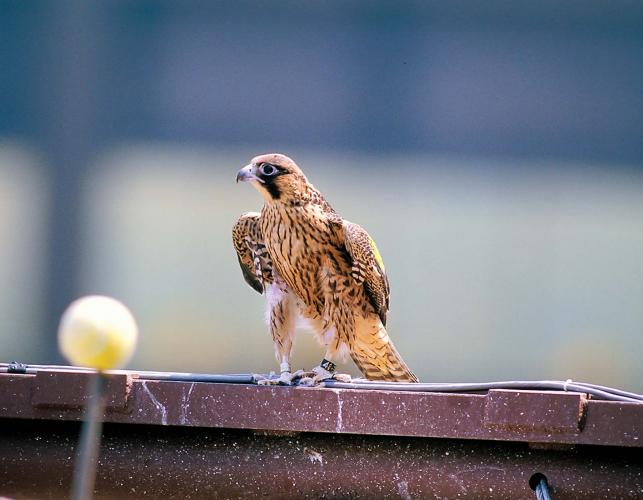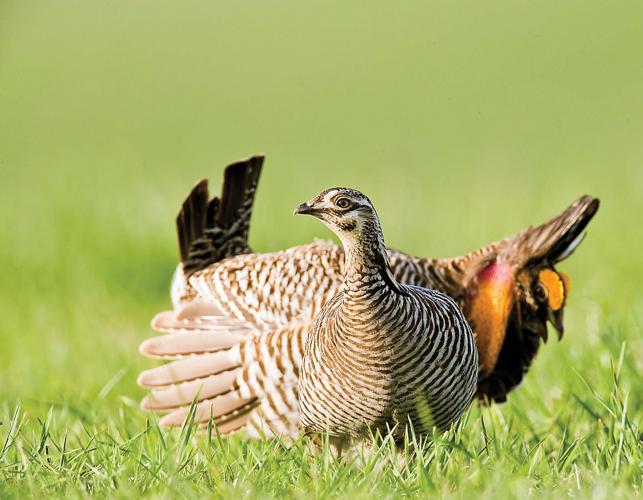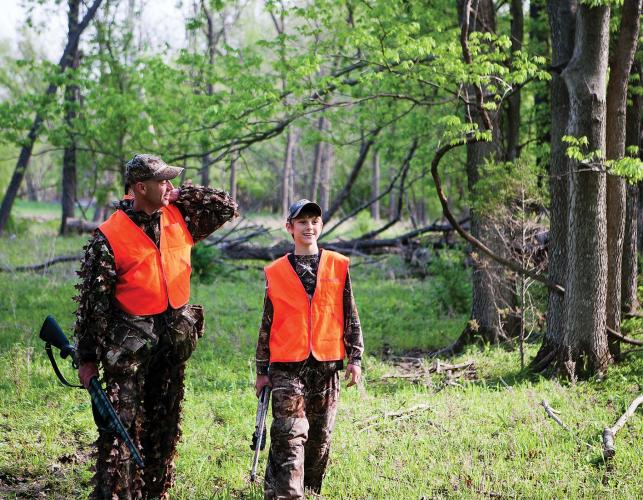Today, Missouri is again home to abundant and diverse wildlife. Some animals benefited from early restocking efforts, better regulations and vigilant enforcement. Others rebounded thanks to habitat improvements, conservation partnerships, and education and outreach efforts. And all wildlife benefited from the unwavering involvement and support of Missourians every step of the way.
Rally to Conserve Dwindling Wildlife
Early settlers found wild turkey, prairie chickens, deer and elk in numbers beyond counting. “The early perception was that wildlife was incredibly abundant—it was an item in the pantry,” says MDC Commissioner Don Johnson. “Clearly those early settlers thought that the wildlife of the state was inexhaustible and limitless, and probably assumed it would be that way forever. Well, it wasn’t.”
Determined to create a brighter future for the state’s wildlife, Missouri’s sportsmen and concerned citizens came together to lay the groundwork for a new sciencebased conservation department. On Nov. 3, 1936, voters approved the measure by the largest margin of any amendment to the state constitution. This amendment gave Missouri the world’s first apolitical conservation department, governed by four citizen conservation commissioners. Their charge: to protect and manage Missouri’s fish, forest and wildlife resources.
The newly created Conservation Commission implemented an entirely different approach to fish, forest and wildlife management. Public desire replaced political pressure, and biological data replaced personal opinion as the basis for management. New conservation concepts centered on the importance of habitat and the responsibility to safeguard the resource.
Conservation—the concept of wise use—allowed the harvest of wildlife at sustainable levels.
The fledgling Conservation Department based many of its programs on a benchmark study written by biologists Rudolf Bennitt and Werner Nagel, A Survey of Resident Furbearers of Missouri, published in 1937. Their findings were grim—only about 2,500 turkeys and 1,800 deer remained in the state. Prairie chickens, ruffed grouse, beavers, otters and raccoons also were scarce. Other species, such as passenger pigeons and Carolina parakeets, were long gone.
In 1937, hunters harvested only 106 deer in the entire state. In 1938, the Department closed deer and turkey seasons statewide and began live-trapping and restocking deer throughout the Ozarks. Efforts to provide the “big three” of food, water and cover for deer and other wildlife took many forms. For example, in 1939, MDC launched a pond program, helping Missourians create more than 50,000 new ponds for wildlife in the decade that followed.
Through the 1940s and 1950s, deer and wild turkey were the focus of the Department’s major restoration efforts. The Department developed deer refuges with food plots and protected these areas from wildfire, overgrazing and poaching. Deer herds responded dramatically.
By 1944, Missouri’s deer population increased to an estimated 15,000, and a bucks-only deer season reopened in 20 southern counties. That year, 7,557 resident hunters harvested 583 deer. In 1959, deer season reopened in all Missouri counties, ushering in a new focus of deer management to maintain desirable population levels. Today, Missouri offers some of the best deer hunting in the country. In recent years, nearly 500,000 gun and bow hunters typically harvest around 300,000 deer annually.
“Deer management today is about managing for stable populations at socially acceptable levels,” says Jason Sumners, MDC resource scientist. “About 93 percent of Missouri’s land is in private ownership. As a result, landowners hold the key to managing deer numbers in rural Missouri. MDC works with landowners to help them achieve their deer management goals.”
Today, Missouri is also one of the top wild turkey hunting states in the country, but this was not always the case. Back in 1938, turkey season was closed because there were so few birds. In 1952, the final tracts of what would become the Peck Ranch Conservation Area were acquired for turkey restoration. From 1954 to 1979, turkeys trapped at Peck Ranch and other areas of the state were relocated to 142 sites in 87 counties. Missouri’s modern turkey season began when the spring turkey season reopened in 1960, during which 698 hunters bagged 94 birds. Fall archery season reopened in 1975, and the first fall firearms season followed in 1978.
Missouri’s wild turkey restoration program is a huge success, and today, Missouri’s turkey population is estimated to be about 500,000 birds strong. All 114 counties now have stable turkey populations that allow hunting, and 101 of these counties have wild turkeys that can be traced back to restocking efforts. In 2011, more than 50,000 birds were harvested.
Past Successes Lead to a Broader Conservation Base
As Missouri’s deer and turkey populations were successfully recovering, it was apparent that many other plants and animals benefited from the improved habitat. “In the early years, those key species were so deficient in numbers that they demanded attention,” says Deputy Director Tim Ripperger. “But as the conservation field has matured, we began to recognize that those game species represent just a small slice of Missouri’s total biodiversity and there are many other creatures out there, some large, many small, that are similarly threatened.”
Beginning in the 1970s, the Department made a pledge to Missourians to embrace a broader conservation approach called the Design for Conservation. It was a plan to conserve the best examples of forests, prairies, marshes and glades; to obtain land for recreation, forestry and conservation of critical habitat; to increase services to the public in the areas of wildlife and forest conservation; and to create a system of conservation nature centers throughout Missouri.
Missouri voters approved the Design for Conservation sales tax in 1976. This one-eighth of 1 percent sales tax provides dedicated funding required for the conservation of fish, forests and wildlife. In addition to deer and turkey, a great variety of wildlife benefits from this broader approach to conservation, ranging from hellbenders and collared lizards, to bluebirds and eagles, to otters and, most recently, elk.
“Most of our conservation success stories involve Missourians digging in their heels to turn around declining populations,” says Gene Gardner, MDC’s wildlife diversity chief. “Bringing back the bluebird, our state bird, is an excellent example of how people came together and did something about it. Our state bird became much more abundant once people started building nest boxes and creating bluebird trails across the state.”
For eagles to rebound, it took a combination of state and federal efforts. Fifty years ago, bald eagles were on the ropes due to habitat loss, poisoning from pesticides, such as DDT, and illegal shooting. From 1962 to 1981, Missouri did not have a single known successful eagle nest. Restoration of habitat, aggressive law enforcement and a national ban on DDT gave eagles a fighting chance. In the 1980s, the Conservation Department placed 74 wild-hatched eaglets in artificial nests throughout Missouri.
Today, more than 200 eagle nests dot the state and bald eagles have been removed from the state and federally endangered species lists. Eagle Days have become popular events throughout the state, with thousands of Missourians flocking to see these majestic birds. In the lower 48 states, the bald eagle population has climbed from an all-time low of 487 nesting pairs in 1963 to an estimated 9,789 nesting pairs today.
Peregrine falcons also benefited from MDC restoration efforts in both St. Louis and Kansas City. Experts believed peregrine falcons would find big city skyscrapers as acceptable as steep cliffs, the peregrines’ preferred habitat. As a result of imprinting those sites on a number of nesting peregrines, these birds now return to the city skylines to bear their young, much to the enjoyment of many city-dwelling nature lovers.
All Wildlife Conservation
Today’s conservationists focus on conserving all plants and animals, and the natural systems on which they depend. This “all wildlife” conservation approach differs from traditional fish and wildlife management, which focused on restoring single species. After all, the survival of one plant or animal is often inextricably linked to the health and well being of the entire ecosystem.
“I expect many people think the Department’s expertise focuses on single species, because some of the best known success stories involve bringing back wildlife that we now highly value,” says John Hoskins, retired MDC director. “But today we strive to conserve wildlife in a broader sense—trees, insects, wildflowers, grasses, animals and all the rest. The descriptive phrase often heard is ‘preserve and restore our state’s biodiversity.’ ”
Wildlife Restoration Continues Today
MDC continues important restoration and conservation efforts today, from the more headline-grabbing species, such as elk, to the tiniest insects. Last year, the Department, in partnership with the Kentucky Department of Fish and Wildlife Resources and the Rocky Mountain Elk Foundation, relocated 34 wild elk from the Appalachian Mountains of eastern Kentucky to Missouri’s Peck Ranch Conservation Area. Decades of ecological restoration have returned Peck Ranch to conditions similar to those that existed here when elk last trod the Ozark hills 150 years ago.
But “smaller” successes are just as important to conserving Missouri’s complex webs of life. The eastern collared lizards, which almost disappeared from the Ozarks due to overgrown glades, are now more common and widespread due to glade restoration and a successful reintroduction program.
Barn owl populations increased in the 1990s after nest boxes were more widely provided. Although barn owl numbers remain low across the state, they were recently removed from the state endangered species list—illustrating how even small efforts can help wildlife rebound.
Small fens in the Ozarks were restored to help the endangered Hine’s emerald dragonfly, in a partnership with landowners and the U.S. Forest Service. This beautiful dragonfly needs very specific wetland habitat that includes wet soils with crayfish burrows. By removing invading trees and keeping the fens open, we ensure the survival of both the crayfish and the Hine’s emerald dragonfly.
Conserving bottomland hardwood forests and associated wetlands benefits a number of bottomland species, including a declining number of western chicken turtles. Although still in danger of extinction, conservation efforts are beginning to show success.
Conservation efforts are also beginning to stabilize the last remaining populations of the massasauga rattlesnakes in Missouri by managing their wet prairie habitat. Persecuted to near extinction in Missouri from fear or misunderstanding, these snakes eat rodents, other small mammals and amphibians found in the wet prairies of northern Missouri.
Challenges Remain
These examples are but a few of the many restoration and conservation success stories in Missouri. Reading these stories of Missouri’s citizen-led efforts to restore wild- life, it is easy to think the hard work of conservation is complete. Yet, the same challenges of ensuring sufficient food, water and cover continue today. In many ways, challenges to wildlife are greater than ever.
“A lot of these habitats are a fraction of what they once were,” says Gardner. “The remaining areas must do double duty to help many more plants and animals make the rebound—from wetlands to forests to grasslands. Sometimes that’s as easy as leaving habitat edges along crop fields, thinning forests or using fire to improve habitat.”
Building on Our Legacy
The Department has worked with tens of thousands of Missourians over multiple generations to benefit many wildlife species and their habitats. “There have been some incredible success stories that now make wildlife readily available to any Missourian who wants to get out there and either pursue them with a gun, fishing rod, binoculars or a camera,” says MDC Director Robert L. Ziehmer.
Looking back at Missouri’s low point for wildlife, and seeing where we are today, “The promise was absolutely fulfilled,” Ziehmer continues. “In the case of deer, populations were restored to a level where we now support annual deer harvest totaling 300,000 taken by archery and gun hunters. We have 500,000 deer hunters, generating more than $1 billion of overall business activity and supporting more than 11,000 jobs. In the case of deer, turkey and other wildlife species, absolutely that promise has been fulfilled.”
MDC is dedicated to helping Missourians conserve our state’s great natural heritage for new generations. Not content to rest on past achievements, the Department is forging ahead with efforts to save prairie chickens, boost quail populations, and find new approaches and partners to further conserve and restore Missouri’s important fish, forest and wildlife resources.
National Wild Turkey Federation
The National Wild Turkey Federation plays an important role in the conservation of Missouri’s wild turkey population, and it helps Missouri remain one of the nation’s top wild turkey states. Missouri has 116 Federation chapters, totaling more than 13,300 members. Approximately half of the proceeds of their chapter fundraisers support the Department’s priority upland habitat projects.
“The Federation has been a tremendous partner in conservation here in Missouri,” says MDC Deputy Director Tom Draper. “Not only have they been responsible for a great deal of on-the-ground wildlife habitat improvement, but they also do an outstanding job of getting folks involved in the outdoors through their outreach efforts.”
The Federation’s primary focuses in Missouri are on habitat enhancement, promoting hunter access, wild turkey research, and outreach and education. Since 1985, the Federation has invested $3.5 million in Missouri. The Federation’s habitat enhancement projects have improved almost 35,000 acres in the state. Significant dollars have also been spent on education, scholarships and outreach events for youth, women and people with disabilities.
In recent years, the Federation’s state chapter has provided significant funds to help landowners make habitat improvements in southwest and northeast Missouri. The state chapter also has partnered with The Nature Conservancy to restore almost 1,000 acres of tallgrass prairie in the Grand River grasslands of north-central Missouri. Learn more at nwtf.org.
Duck Stamps Benefit Wildlife and People
Since 1934, the sales of federal Duck Stamps have generated more than $750 million to help purchase or lease more than 5.3 million acres of waterfowl habitat in the United States. For every $1 spent on Duck Stamps, 98 cents goes directly to purchase vital habitat for protection in the National Wildlife Refuge System.
Waterfowl are not the only wildlife to benefit from Duck Stamps. Many plants and animals that rely on wetland habitats have also prospered, including a variety of birds, mammals, fish, reptiles and amphibians. In addition, an estimated one-third of the nation’s endangered and threatened species find food or shelter in refuges established using Duck Stamp funds.
“The Duck Stamp Program did more than just raise dollars for habitat; the artwork reached more people, outside of hunters, to become passionate and engaged in conservation work,” says Doyle Brown, MDC’s federal aid coordinator.
“If there were no duck stamps, there would be virtually no waterfowl or other migratory birds in Missouri or in the rest of the country.”
People benefit from the Duck Stamp Program, too. Missourians have places to enjoy their hunting heritage and places to boat, fish and watch wildlife. Moreover, healthy wetlands help purify water supplies, store floodwater, reduce soil erosion and sedimentation, and provide spawning areas for fish important to anglers.
Understandably, the Federal Duck Stamp Program has been called one of the most successful conservation programs ever initiated and is a highly effective way to conserve America’s vital wetland resources. Learn more at go.usa.gov/nmj.
















Also In This Issue


And More...
This Issue's Staff
Managing Editor - Nichole LeClair Terrill
Art Director - Cliff White
Staff Writer - Bonnie Chasteen
Staff Writer - Jim Low
Photographer - Noppadol Paothong
Photographer - David Stonner
Designer - Stephanie Thurber
Artist - Mark Raithel
Circulation - Laura Scheuler






















